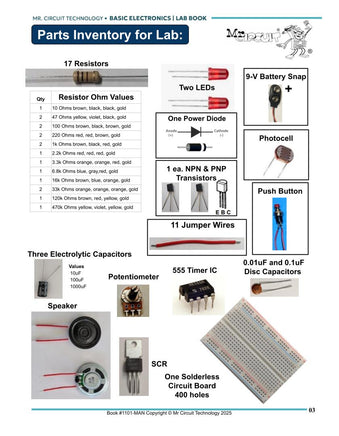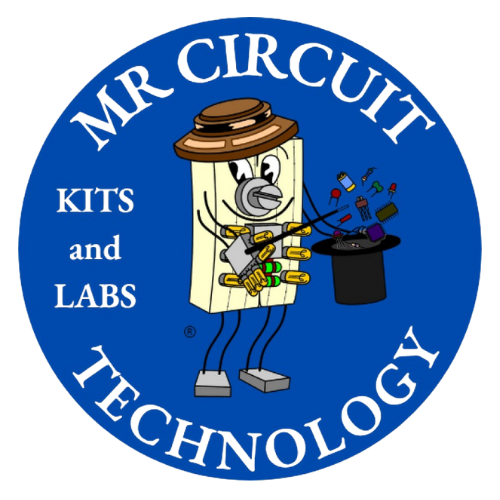
|
1101-C01 |
Resistor 10 ohms |
(1) |
|
1101-C02 |
Resistor 47 ohms |
(2) |
|
1101-C03 |
Resistor 100 ohms |
(2) |
|
1101-C04 |
Resistor 220 ohms |
(2) |
|
1101-C05 |
Resistor 1,000 (1k) ohms |
(2) |
|
1101-C06 |
Resistor 2,200 (2.2k) ohms |
(1) |
|
1101-C07 |
Resistor 3,300 (3.3k) ohms |
(1) |
|
1101-C08 |
Resistor 6,800 (6.8k) ohms |
(1) |
|
1101-C09 |
Resistor 16,000 (16k) ohms |
(1) |
|
1101-C10 |
Resistor 33,000 (33k) ohms |
(2) |
|
1101-C11 |
Resistor 120,000 (120k) ohms |
(1) |
|
1101-C12 |
Resistor 470,000 (470k) ohms |
(1) |
|
1101-C13 |
Speaker with leads |
(1) |
|
1101-C14 |
Capacitor 10uF electrolytic |
(1) |
|
1101-C15 |
Capacitor 100uF electrolytic |
(1) |
|
1101-C16 |
Capacitor 1000uF electrolytic |
(1) |
|
1101-C17 |
Capacitor 0.01 uF disc |
(1) |
|
1101-C18 |
Capacitor 0.1 uF disc |
(1) |
|
1101-C19 |
Potentiometer with leads |
(1) |
|
1101-C20 |
SCR |
(1) |
|
1101-C21 |
Diode 1N400 |
(1) |
|
1101-C22 |
LED (red) |
(2) |
|
1101-C23 |
Photocell |
(1) |
|
1101-C24 |
Battery Snap w/4” solid leads |
(1) |
|
1101-C25 |
555 Timer IC in black foam |
(1) |
|
1101-C26 |
Pushbutton Switch N/O with leads |
(1) |
|
1101-C27 |
Transistor NPN |
(1) |
|
1101-C28 |
Transistor PNP |
(1) |
|
1101-C29 |
Jumper Wires (3 3/4” long solid wire) |
(11) |
